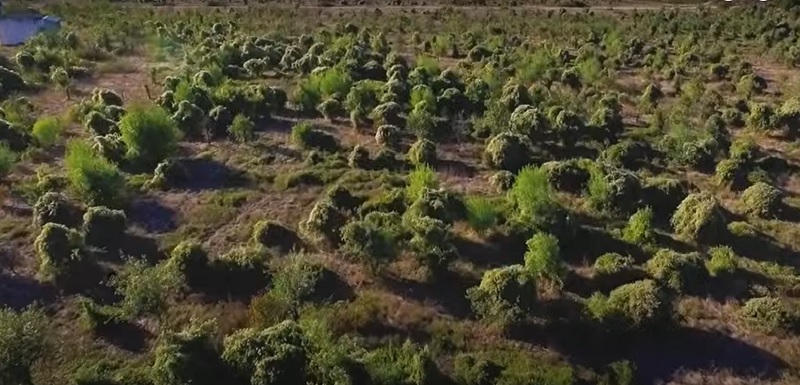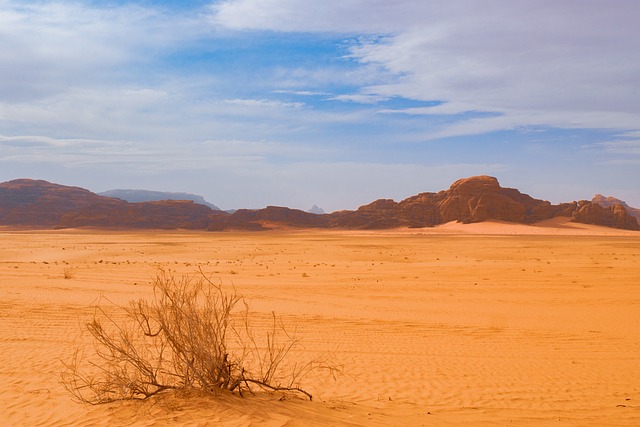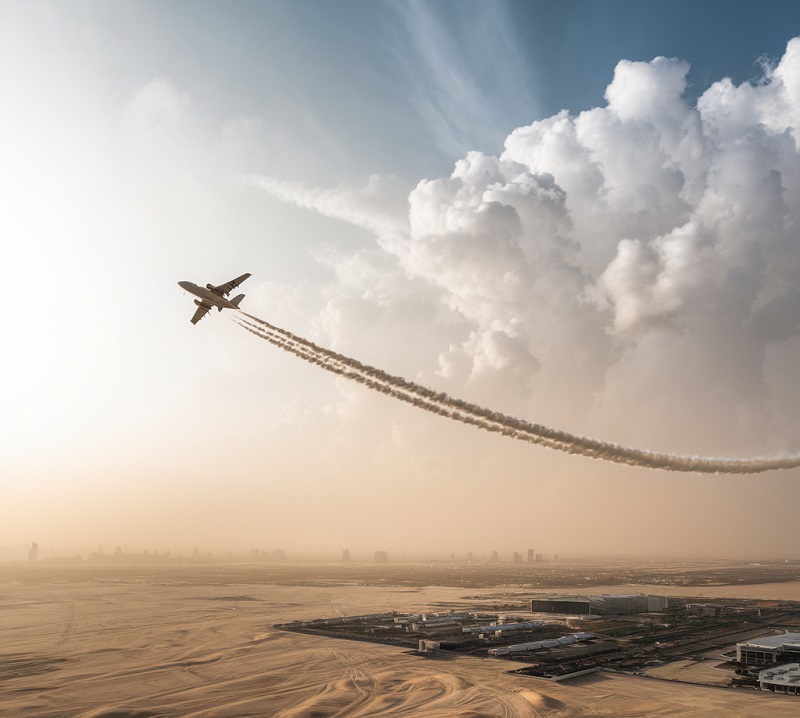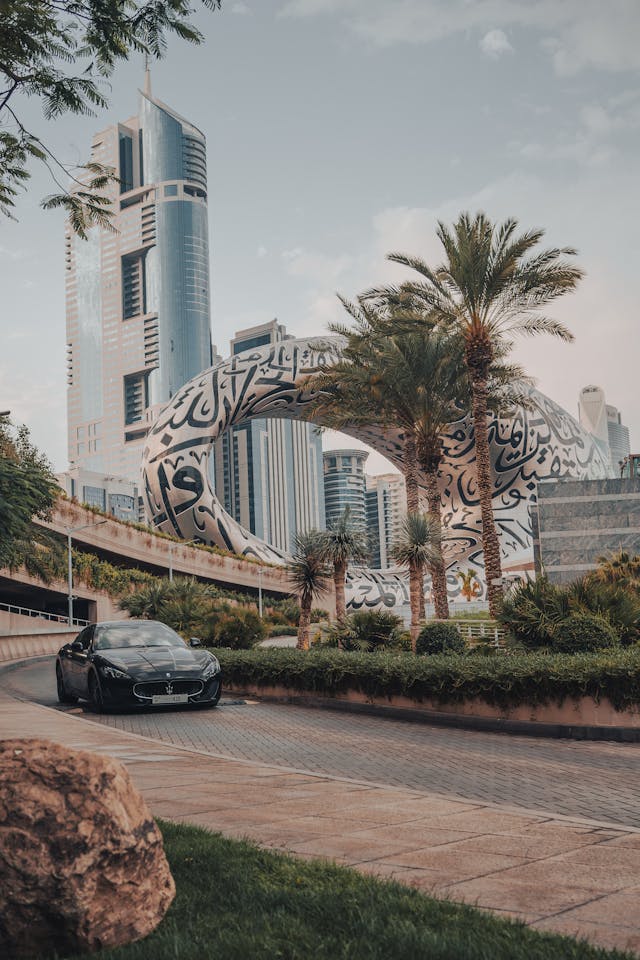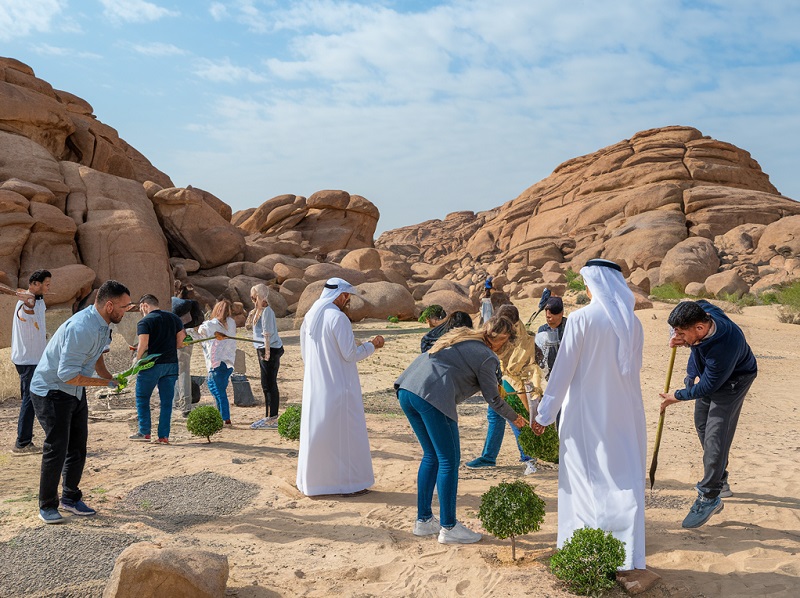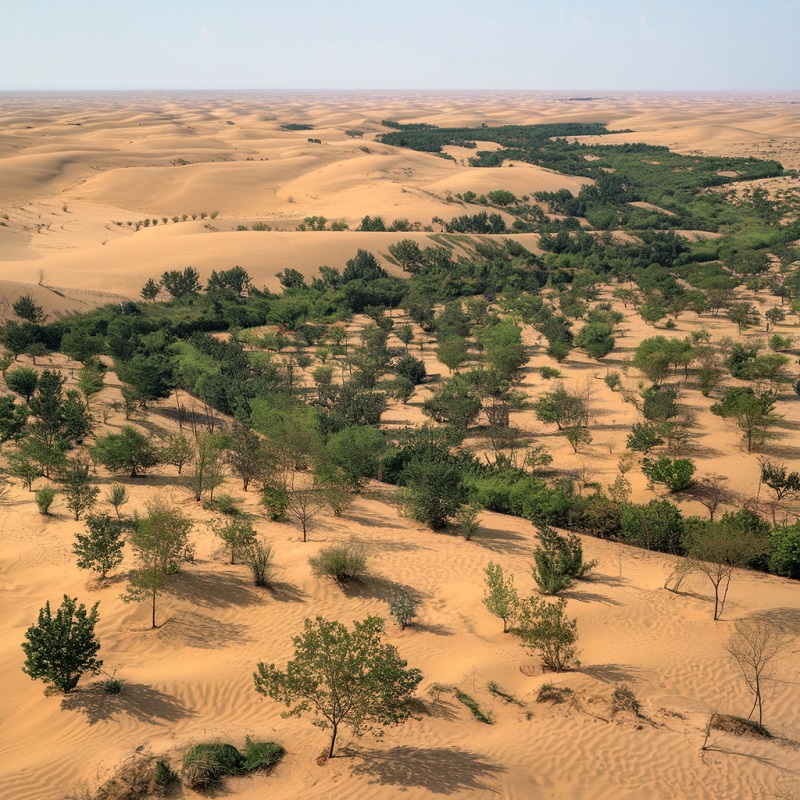
Discover how cloud seeding in the UAE enhances rainfall, supports water sustainability, and combats arid conditions. Learn about the technology, effectiveness, and future of this innovative weather modification technique in the UAE.
The United Arab Emirates is undergoing a dramatic transformation as green spaces emerge in its vast deserts. This initiative, known as desert greening, represents a significant investment in the nation’s future, aiming to address the pressing issue of water scarcity. With less than 200 mm of rainfall each year, the UAE faces challenges linked to climate change and increasing population demands. The government has responded decisively by investing in innovative methods, including cloud seeding, to enhance water resources.
As the UAE strives to evolve from a largely arid landscape to a more verdant environment, it embarks on ambitious afforestation projects. The “One Million Trees” initiative and the UAE Green Agenda for 2030 exemplify the commitment to sustainable development. These efforts not only aim to combat desertification but also enhance the overall quality of life and environmental resilience in the region.
Key Takeaways
- The UAE is implementing desert greening to combat water scarcity and support population growth.
- Innovative projects like cloud seeding and the “One Million Trees” initiative aim to enhance the environment.
- Sustainable practices are essential for the UAE’s future and economic stability.
Greenery in the UAE Desert
In the vast deserts of the United Arab Emirates, areas of green are appearing among the sandy landscape. This is a planned effort known as desert greening. Given the challenges of water scarcity, this initiative could prove to be one of the UAE’s most important investments.
The United Nations predicts that by 2025, 1.8 billion people will experience severe water shortages. Desert countries face even greater difficulties as they struggle with diminishing water supplies due to climate change. The UAE receives less than 200 mm of rainfall each year, which is significantly less than places like London and Singapore.
To support its development and growing population, the UAE has dedicated over $20 million to research cloud seeding, a method that aims to enhance rain production in clouds. This effort began in the early 2000s with collaboration from the National Atmospheric Research in the U.S. By 2050, water availability in the Gulf region could drop by 50%.
The UAE has been actively working against desertification, which occurs when land loses its ability to support plant life. Approximately 80% of the UAE’s 83,000 square kilometers is desert. Globally, about 12 million hectares of land are lost each year due to drought and desertification. Recent studies show the UAE lost around 33,000 hectares from 2002 to 2018, mainly because of land degradation.
Over time, the UAE transformed from a fishing hub into a modern urban center. Historically, the UAE has engaged in afforestation, a practice aimed at planting trees in barren areas. The “One Million Trees” initiative was launched by Dubai’s ruler to plant 250,000 trees each year. Olive trees, palms, and ghafs, the UAE’s national tree, now fill previously lifeless areas.
Planting trees includes not just selecting the right species but also designing the landscape to help them thrive. A dedicated tree nursery for this initiative covers over 130,000 square meters. Challenges arose when a mega shopping project threatened the nursery’s location, leading to the loss of many trees.
In January 2015, the UAE Cabinet introduced the Green Agenda for 2030, focused on establishing a sustainable economy. Plants play a crucial role in reducing carbon dioxide, making them key players in improving air quality.
The UAE’s green efforts show similarities to other countries like China, which undertook a similar project in the Kubuqi desert. There, solar farms and other renewable energy initiatives have greened a third of the desert over three decades.
Cloud seeding efforts in the UAE involve about 1,000 hours of operation annually, managed from the National Center of Meteorology in Abu Dhabi. The cloud seeding process relies on detailed weather tracking and specialized aircraft that release a salt substance into clouds. This helps larger droplets form and eventually leads to rainfall.
To measure the success of their greening efforts, the UAE is exploring various strategies to increase water supply while conserving it. These include desalination and selecting low-water-use plants. As the region continues to develop its agricultural landscape, maintaining a balance in water usage remains critical.
Water Shortages and Challenges in the Middle East
In the vast deserts of the United Arab Emirates (UAE), greenery springs up through planned efforts called desert greening. This approach is part of a significant investment for the future. The United Nations predicts that by 2025, about 1.8 billion people will face extreme water shortages. This crisis presents a serious challenge, especially for nations in arid regions where water is already scarce.
The Middle East is known to be one of the most water-stressed areas in the world. Twelve out of seventeen of the globe’s most affected countries are located here. The UAE receives less than 200 mm of rainfall annually, which starkly contrasts with places like London and Singapore, which saw 1,051 mm and 3,012 mm of rain in 2022, respectively.
To counteract water scarcity, the UAE government has invested over $20 million in cloud seeding. This method aims to increase rainfall and enhance groundwater storage. It began under an initiative led by His Highness Sheikh Mansour around 2000 and involved collaboration with the National Atmospheric Research in the U.S. Without intervention, predictions show that water availability per capita in the Gulf region could drop by 50% by 2050.
Desertification, where land becomes unproductive, is another pressing issue. The UAE is primarily desert, covering 80% of its 83,000 square kilometers. Worldwide, an estimated 12 million hectares of land are lost each year due to drought and desertification. From 2002 to 2018, the Emirates lost nearly 33,000 hectares of land, leading to challenges for over 3 billion individuals living in degraded ecosystems.
Historically, the UAE has engaged in afforestation efforts, which involve planting trees in barren areas. A notable initiative, “One Million Trees,” was started by the ruler of Dubai to plant 250,000 trees annually, including olive and ghaf trees, the UAE’s national tree.
Despite setbacks, such as the disruption from the proposed mega shopping center ‘Mall of the World’ on tree nursery land, progress has been made. In 2015, the UAE Cabinet approved the UAE Green Agenda for 2030, focusing on sustainable development and reducing carbon dioxide levels through the use of plants.
Other nations are also embarking on similar paths. For example, a large project in China transformed half of the Kubuqi desert. The UAE uses cloud seeding operations extensively, often deploying aircraft to release salt substances that promote rain when conditions allow.
With ongoing research, farmers and scientists are finding ways to enhance agriculture in the region while conserving water. Climate-related water scarcity could potentially cost the Middle East up to 6% of its GDP by 2050, emphasizing the importance of a forward-thinking approach to water management and landscape greening.
Climatic Context and Cloud Seeding Efforts in the UAE
The United Arab Emirates (UAE) faces unique climate challenges. With less than 200 mm of rainfall each year, the nation struggles to meet the water needs of its population and environment. In contrast, cities like London and Singapore receive over 1,000 mm and 3,000 mm of rainfall annually, respectively. This limited precipitation contributes to severe water scarcity, affecting both people and ecosystems.
To combat these challenges, the UAE government has invested over $20 million in cloud seeding research. This method aims to enhance rain in the clouds and improve groundwater storage. Cloud seeding operations began in early 2001 and have become crucial, especially with projections indicating a potential 50% reduction in water availability per capita in the Gulf region by 2050.
Desertification is a significant issue for the UAE. Approximately 80% of the Emirate consists of desert, and the rate of land degradation is concerning. From 2002 to 2018, the UAE lost around 33,000 hectares of land due to these environmental challenges. In response, various initiatives have emerged, including ongoing efforts to afforest and green once barren areas.
The “One Million Trees” initiative, announced by Dubai’s ruler, plans to plant 250,000 trees each year, focusing on resilient species like the ghaf tree. A significant tree nursery supports this effort, covering over 130,000 square meters. Engineering the landscape plays a vital role in ensuring these trees survive in harsh conditions.
Cloud seeding is monitored and controlled by the National Center of Meteorology in Abu Dhabi. The UAE conducts about 1,000 hours of cloud seeding per year. This process involves planes releasing a salt substance into targeted clouds to stimulate rainfall. With 110 weather stations across the country, the center efficiently tracks weather patterns to optimize seeding operations.
As the UAE continues its mission to combat climate-related challenges, its efforts in both cloud seeding and ecological restoration demonstrate a commitment to creating a sustainable future for its citizens and environment.
Fighting Against Desert Expansion
In the United Arab Emirates, large patches of greenery are appearing in the vast deserts. This effort, known as desert greening, is a carefully planned initiative aimed at combating the effects of desertification. The United Nations predicts that by 2025, 1.8 billion people will face extreme water shortages. Therefore, water availability is crucial for the survival of people, animals, and plants.
The UAE is characterized by very low rainfall, averaging less than 200 mm annually. This is significantly less compared to cities like London and Singapore, which received over 1,000 mm and 3,000 mm of rain in 2022, respectively. Due to climate change, securing enough water for the population has become a challenge. To address this, the UAE government has dedicated over $20 million to research cloud seeding. This technique aims to increase rainfall, with the goal of enhancing groundwater storage.
The region faces a potential 50% drop in water resources by 2050. Desertification in the UAE means that much of the land can no longer support plant life. About 80% of the Emirates is desert, contributing to a global concern where 75% of the Earth’s land is degraded. Each year, approximately 12 million hectares of land are lost globally due to drought and desertification, affecting over 3 billion individuals.
Efforts to restore greenery include afforestation projects that aim to increase tree populations. The “One Million Trees” initiative, started by the ruler of Dubai, set a target to plant 250,000 trees annually, boosting biodiversity in the region. The Emirate has a long-standing tradition of planting trees in barren areas, recognizing the power of vegetation to combat these harsh conditions.
To ensure the survival of these plants, proper landscaping is essential. Techniques to capture and retain water make it easier for trees to thrive in the arid environment. A tree nursery created for this initiative spans over 130,000 square meters, although it faced challenges from urban development plans.
In January 2015, the UAE Cabinet introduced the Green Agenda for 2030, focusing on fostering a sustainable economy. Plants play a significant role in filtering carbon dioxide, making them vital in the fight against climate change.
Other countries, like China, are also engaging in similar desert greening efforts. For instance, the Kubuqi Desert project in Inner Mongolia has seen significant success in transforming parts of its landscape over three decades. Cloud seeding technology is employed in both the UAE and China, aiming to manipulate weather patterns to boost rainfall and protect agricultural zones.
In the UAE, around 1,000 hours of cloud seeding occur each year. The National Center of Meteorology in Abu Dhabi oversees these operations, analyzing data from approximately 110 weather stations to monitor cloud activity and forecast conditions. Techniques involve assessing cloud formations and using specialized aircraft to release materials that encourage rainfall.
These initiatives indicate that the UAE is dedicated to reversing the effects of desertification and promoting a greener environment. With innovative approaches to water management and afforestation, they aim to create a more sustainable future.
Development and Change of the Landscape in the UAE
The landscape of the United Arab Emirates is undergoing a remarkable transformation. Amid the vast deserts, areas of greenery are emerging, a process known as desert greening. This effort is crucial for the nation’s future, as water scarcity pressures rise. By 2025, an estimated 1.8 billion people will face severe water shortages, making water conservation a top priority for the UAE.
The UAE currently sees less than 200 mm of rainfall each year, a stark contrast to cities like London, which received 1,051 mm in 2022, and Singapore, at 3,012 mm. The government has committed over $20 million to research cloud seeding since early 2001. This technique aims to enhance rainfall and support ground water supplies, addressing the challenge posed by climate change.
Desertification is another major concern, with 80% of the UAE’s 83,000 square kilometers classified as desert. The World Bank reports a loss of approximately 33,000 hectares of land in the Emirates from 2002 to 2018. The effects of drought and land degradation threaten over 3 billion people globally, particularly those in arid regions.
Historically, the UAE has focused on afforestation, planting trees in barren areas. The “One Million Trees” initiative, launched about two decades ago, aimed to plant 250,000 trees per year. This initiative helped introduce species like olive, palm, and ghaf trees, which are essential for combating desertification.
A tree nursery for this project covers 130,000 square meters. Yet, the vision faced challenges, including the cancellation of the ‘Mall of the World’ mega shopping center that would have affected the nursery. Despite this, the UAE Cabinet approved the UAE Green Agenda for 2030 in January 2015, promoting a greener economy.
The role of plants is vital as they help capture carbon dioxide, thus contributing to climate action. The UAE also mirrors global efforts in places like China, where projects such as the greening of Kubuqi Desert have seen significant success.
Cloud seeding operations are a key element, executed from the National Center of Meteorology in Abu Dhabi. This technology is used to increase rainfall, boasting 1,000 hours of cloud seeding annually. The process involves aircraft releasing salts into promising clouds, leading to condensation and increased precipitation.
The UAE is exploring various methods to deal with water scarcity, including desalination and planting water-efficient crops, while continuing its dedication to creating a greener landscape. Each effort supports the well-being of its citizens and the environment.
Tree Planting Projects and the Initiative for One Million Trees
In the deserts of the United Arab Emirates, significant efforts are underway to create green spaces. This initiative is known as desert greening, aimed at addressing the challenges of water scarcity influenced by climate changes. The UAE receives low rainfall, making it necessary to implement strategic action for its growing population.
To combat desertification, which results in unproductive land, the UAE has a history of afforestation. The “One Million Trees” initiative was launched by Dubai’s ruler two decades ago. The goal is to plant 250,000 trees each year, in partnership with the Dubai Police Academy. This effort includes various tree species, such as olive, palm, and ghaf, the national tree.
The initiative also focuses on effective landscape management. Engineers design the planting areas to capture and retain water, ensuring the trees can thrive. A nursery for this project extends over 130,000 square meters, facilitating the growth of these trees.
Despite the ambitious plans, challenges occurred. The proposed construction of the ‘Mall of the World’ threatened to disrupt the tree nursery. Fortunately, that project was abandoned, allowing for continued support for the trees.
In January 2015, the UAE Cabinet endorsed the UAE Green Agenda for 2030, aimed at creating a sustainable economy. Plants play a vital role in absorbing carbon dioxide, making them crucial for environmental health. This green initiative is not only limited to the UAE; countries like China also pursue similar desert greening projects, showcasing a global commitment to combating desertification.
Through advanced techniques like cloud seeding, the UAE aims to enhance rainfall as part of its water conservation strategies. This multi-faceted approach combines innovative technology and natural solutions to promote a greener and more sustainable future.
Economic Impacts and Land Challenges
In the deserts of the United Arab Emirates, a significant effort to create green spaces is underway. This process, known as desert greening, is crucial for supporting the growing population and economic growth. Water scarcity is a major concern, especially since the UAE only receives around 200 mm of rain each year, compared to other regions like London, which gets over 1,000 mm, or Singapore, which receives more than 3,000 mm.
Key Initiatives and Investments
The UAE government has invested over $20 million in research for cloud seeding to enhance rainfall and increase groundwater storage. This effort began in the early 2000s, aiming to combat the expected 50% reduction in water availability per capita by 2050 across the Gulf region.
- Cloud Seeding Goals:
- Increase rainfall
- Enhance groundwater resources
Land Degradation Issues
Desertification poses a significant threat to available arable land in the UAE. Approximately 80% of the country is desert, and it’s estimated that 75% of the world’s land is degraded. The World Bank reports that the UAE has lost nearly 33,000 hectares of land between 2002 and 2018 due to land degradation. These losses affect over 3 billion people globally, especially those in desert ecosystems.
Afforestation and Green Initiatives
To address these challenges, the UAE has implemented initiatives like the “One Million Trees” project, which aims to plant a significant number of trees each year. This program involves:
- Planting trees that are well-suited for the desert environment
- Engineering the landscape to support tree survival
- Creating dedicated nurseries for growing these trees
Despite these efforts, challenges continue to threaten green projects. For example, plans for large developments, such as the Mall of the World, have led to conflicts over land use, resulting in setbacks for tree planting initiatives.
Future Prospects
The UAE Cabinet has endorsed the UAE Green Agenda for 2030, focusing on creating a sustainable economy and enhancing the environment. This includes using plants to absorb carbon dioxide and reduce greenhouse gases.
Other countries are pursuing similar desert greening projects, providing a model for sustainable practices. These collaborative efforts signify a push toward recovery in often neglected ecosystems.
The UAE’s Green Vision for 2030 and Carbon-Sequestering Efforts
In the deserts of the United Arab Emirates, initiatives aiming for desert greening are taking shape. This strategic transformation is a response to significant agricultural and water challenges faced by the region, where water scarcity is alarming. The UAE receives less than 200 mm of rainfall annually, starkly contrasting with cities like London and Singapore, which receive much higher amounts. The burden of ensuring sufficient water for its growing population has led the UAE government to invest in innovative solutions, including cloud seeding.
Cloud seeding enhances precipitation by injecting substances into clouds, aiming to increase groundwater storage. The UAE’s program began in the early 2000s, driven by a directive from His Highness Sheikh Mansour. The objective is clear as scientists predict a possible 50% reduction in water availability per person by 2050 across the Gulf region. As desertification threatens over 3 billion people globally, the UAE’s commitment to creating sustainable green spaces becomes even more critical.
Afforestation efforts have deep roots in the UAE’s history. Initiatives like the “One Million Trees” project focus on planting trees such as olive, palm, and ghaf trees, the national symbol. Techniques for selecting and planting these trees are carefully designed to maximize survival in harsh conditions. Even with setbacks, like the abandoned ‘Mall of the World’ project that endangered a tree nursery, the vision for a greener UAE perseveres.
The UAE Green Agenda for 2030 emphasizes building a green economy. By promoting plants that absorb carbon dioxide, the agenda showcases nature’s critical role in addressing climate change. The UAE is also taking cues from global examples, with projects like the successful greening of parts of Kubuqi, in China. This highlights a shared ambition to combat environmental challenges through innovative, nature-based solutions.
Through cloud seeding, the UAE performs around 1,000 hours of weather manipulation annually. This operation is managed from the National Center of Meteorology in Abu Dhabi, which uses cutting-edge technology to monitor weather patterns and optimize rainfall enhancement. The success of these efforts is evident in broader agricultural advancements, while the country works toward efficient water management to aid the cultivation of plants that require less water.
Investments in these technologies are not just about the present but address potential future challenges. The World Bank indicates that climate-related water issues could cost the region up to 6% of its GDP by 2050. The UAE’s commitment to greening initiatives ultimately aims to ensure healthier ecosystems and communities, building resilience against the challenges of climate change.
Global Initiatives: Transformation of China’s Kubuqi Desert
In the Inner Mongolia Autonomous Region, China is making significant strides in transforming the Kubuqi Desert. This project began in 1988 when a local company teamed up with the Beijing government to invest in solar farms and renewable energy projects. Over the years, this collaboration has enabled the greening of one-third of the desert, effectively preventing sand dunes from invading agricultural lands.
The total investment in the Kubuqi project has reached approximately $1.8 billion over 50 years, reflecting China’s commitment to combating desertification. The United Nations Environment Programme recognizes this effort as a key player in restoring ecological balance in arid regions.
Like the UAE, China employs cloud seeding technology to manage weather patterns. This method helps protect vital farming areas and ensures clear skies for significant events. The initiative in Kubuqi mirrors efforts seen in the UAE, showcasing a shared global approach to desert greening.
Environmental specialists have noted that these initiatives not only improve greenery but also enhance public health. Plants play a crucial role in absorbing carbon dioxide and other greenhouse gases, contributing to environmental sustainability.
Close coordination among experts is essential for the success of such expansive projects. Teams monitor weather conditions, track cloud formations, and utilize advanced technologies to optimize rainfall through cloud seeding.
Both the UAE and China exemplify how nations can come together in the fight against desertification, employing modern techniques and technology to transform their landscapes for a sustainable future.
Cloud Seeding: Methods and Activities in the UAE
In the vast deserts of the UAE, efforts to create greenery involve a technique known as cloud seeding. This method is aimed at increasing rainfall, which is critical for freshwater storage. Due to the extreme water scarcity in the region, the UAE government has committed significant resources, exceeding $20 million, to enhance this process.
How Cloud Seeding Works
- Preparation: Before operations begin, meteorologists assess weather forecasts for suitable cloud conditions.
- Deployment: Aircraft are dispatched to areas with promising clouds. The planes target the clouds at the right stage, where updrafts are present.
- Seeding Process: The aircraft release a salt substance from flares. This creates larger droplets within the clouds, leading to increased rainfall.
Monitoring and Coordination
- The National Center of Meteorology in Abu Dhabi coordinates these efforts, managing around 1,000 hours of cloud seeding operations annually.
- A network of approximately 110 weather stations provides real-time data about wind patterns and cloud formations, facilitating informed decision-making for when and where to conduct seeding.
Impact on Water Resources
The goal of cloud seeding is not only to increase rainfall but also to support sustainable water management. As the UAE focuses on greening its landscape, this technique plays a crucial role in addressing water scarcity challenges faced by the region. The success of these operations contributes to broader initiatives aimed at enhancing the environment and supporting agricultural activities while preserving precious water resources.
Evaluating the Success and Effects of Green Projects
In the deserts of the UAE, significant efforts are underway to increase green spaces and combat water scarcity. The country grapples with less than 200 mm of rainfall each year, making water management crucial. This challenge prompted the government to invest over $20 million in cloud seeding, a method aimed at enhancing rain and increasing groundwater storage.
The “One Million Trees” initiative began two decades ago, with a goal of planting 250,000 trees each year across Dubai. This effort involved collaboration with the Dubai Police Academy. Despite setbacks, like the failed ‘Mall of the World’ project that threatened the tree nursery, the program has been vital in combating desertification and improving the environment.
Cloud seeding operations are conducted at the National Center of Meteorology, where expert teams monitor weather patterns to optimize rain enhancement. Approximately 1,000 hours of cloud seeding are performed each year, helping to increase rainfall and boost greenery.
The results of these green initiatives can be tracked through various factors. The UAE’s focus on innovative agricultural methods, such as using water-efficient plants, is key. Monitoring the effectiveness of these projects is essential as they contribute not only to environmental health but also to economic stability in a region facing climate-related challenges.


